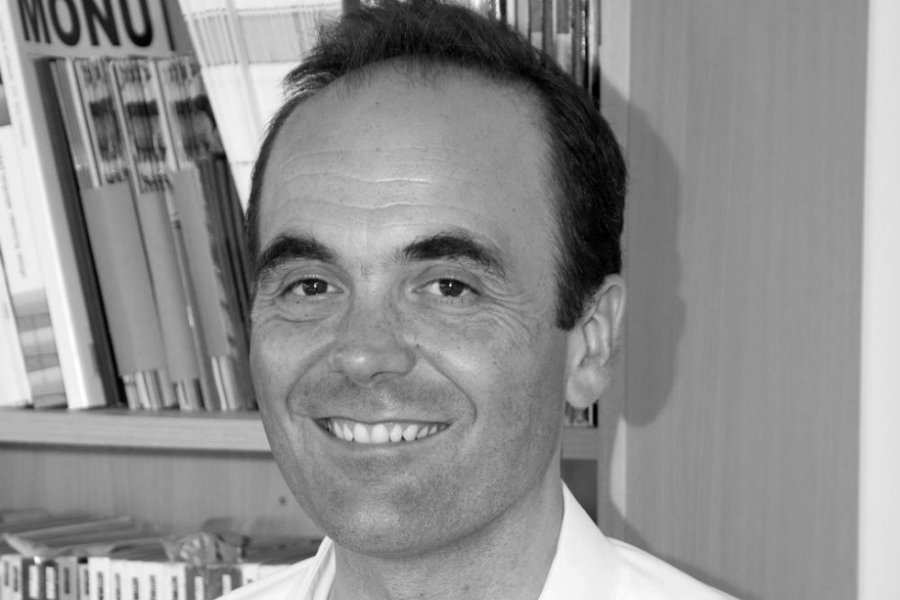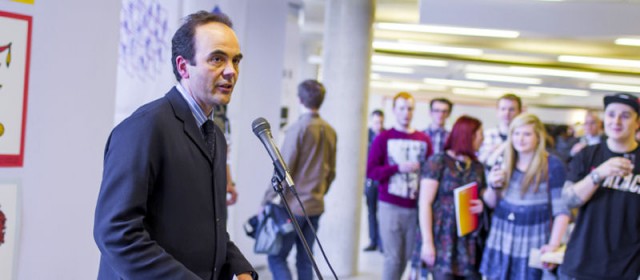The Big Interview: Juan Cruz

We talk to Liverpool John Moores University’s Art School Director about leaving Liverpool, artists as entrepreneurs, and what makes a great art school…
Just before Christmas, we were hit with the surprise announcement that Professor Juan Cruz is stepping down as Director at Liverpool School of Art & Design (LJMU) to be the new Dean of the School of Fine Art at The Royal College of Art (RCA), London. Here, he predicts what direction LJMU will take in his absence, as well as reflecting on his experiences and achievements.
First things first: you’re not leaving LJMU because of the recent controversial Art School re-brand are you?
No! No, no, no.
Phew! Congratulations on the new job; what will you be doing?
Thank you. The job is Dean of Fine Art at the Royal College, and it brings together four programmes around fine art — painting, sculpture, printmaking and photography, as well as some pathways into performance and film and video. The Dean role was established about two or three years ago; there are six schools and each has a Dean. The role really is to look after the school, sort of as an administrative and artistic leader in the school, but also broader senior management of the RCA. It’s quite different; it’s an entirely postgraduate institution, everybody there is doing MA or doctoral programmes.
Have you worked there before?
No never. I’m very much an outsider there in that I didn’t study there; I’ve given one lecture there many years ago and also examined a PHD, again, about ten years ago. I know a lot of people there, but no, never worked there before.
You’ll be looked after in the staff room then!
Haha, yes I hope so.
What have your six years at LJMU been like?
It’s been brilliant. I feel really lucky that I’ve had the opportunity to work at the school, to a great extent the things we’ve managed to do here are the reasons I got the job at the RCA, and it’s been a really busy few years. We’re already quite well developed, especially with cultural organisations around the city. Those relationships were there when I arrived, but I think what we’ve done since then is to really cement them and institutionalise them, have some solidity in appointments we’ve made, collaborative projects, so that’s been really good, and has contributed a lot towards our research agendas; we’ve developed the Exhibition Research Centre (read our feature here), and we’ll be developing more centres soon.
Then internally, and perhaps a little bit less visibly, we’ve done quite a bit to share some of the good practice that was going on, bringing some of the programmes that weren’t doing so well up to the standard of those that were. We’ve done quite a lot of work on the workshops and the quality of provision that the students enjoy. So it’s been amazing, incredibly busy, and I couldn’t have worked harder at it, but its been fantastically rewarding. The university has been very supportive of what we’ve done; particularly the new administration and Nigel Weatherill (Vice Chancellor) has been very supportive of the School of Art and Design.
You’ve managed to squeeze a lot in, including successful links and projects with the University of Shanghai, the AHRC, Arts Council and NESTA, in addition to the €2.5 million five-year European Union funded project, The Uses of Art. What’s been your proudest achievement?
Gosh. Well, I think the academic posts that we’ve established and what they’ve achieved, particularly in the Exhibition Research Centre and the research centres we’ll be establishing moving forward. I think that’s really kind of given us a certain profile nationally and internationally. The work we’ve done to establish a workable structure in the workshops, I feel really proud of that; that was a tough process, but we now have workshops that are really useful to the students. And the programmes that have been struggling with certain things… We’ve had the opportunity to take on a few things that weren’t going that well and really made them work.

Some may say that LJMU’s Fine Art programme has been struggling over the past few years; where do you leave the department and the School of Art and Design in general? What does its future look like?
I think Fine Art programmes around the country have had to kind of think a little bit about how they formulate themselves and how they think about their subject; ours is no exception. There’s been quite a lot of work on how we deliver a Fine Art programme that is true to what a Fine Art programme should be today — articulates the contemporary condition of fine art whilst also holding on to core vales of delivery, like one-to-one tutorials and group seminars. There’s always work to do on those things. But certainly the last feedback we’ve had from students and the atmosphere in the place I think is really lively at the moment. I think it’s really hard to leave a job, because you’ve invested a lot in it, but it’s in pretty good shape as a school.
Where do you think increased fees fit into this? How is it affecting courses and student expectations?
A couple of years ago when the fees were introduced for the first time, we all wondered, and I suppose anybody working in universites was very anxious; would students come to university, would they come to our university and our course? I think we’ve started to answer those questions for ourselves, in the sense that recruitment remained really buoyant through that period. Certainly in the School of Art and Design, some of the work we’ve done to enhance the reputation of the school has contributed to that.
To be honest, I’m not really sure what impact it’s had on students; it seems to me that the fees are probably having less of an impact than we imagined it might do. Longer term that may change… universities have had to think a little bit harder about what kind of experience that students are getting; clearly universities have had to make sure that they’re doing everything really well. On the whole, good universities should have always thought that, so there shouldn’t have been a change there, but I think the shift may be more gradual than we imagined, if there is one.
Have you noticed fewer mature students as a direct result of the increased fees?
We still have quite a few mature students, but I think that is one of the areas where, certainly in the sector, there’s an expectation that there will be fewer mature students coming in.
You’re actively involved in Tate Liverpool, the John Moores Painting Prize and have a close partnership and involvement with Liverpool Biennial. Will you continue to be involved despite your move to London?
Yeah I hope so. The role at Tate Liverpool Council, I’m on my second term now, and that would probably due to run out in a years time I think. I will certainly remain on that council as long as they want me. I’m trustee of the John Moores Painting Prize and again I intend to remain on that board… I’ve put a huge amount of effort into my work in Liverpool, I have got lots of friends here, lots of connections, and I don’t want to let go of them. I very much want to maintain that contact. I’m starting the new job at the end of April 2014 and my family will join me over the summer.
We’ve got quite a few projects starting over the summer; the John Moores Painting Prize artists will be resident in the school and students will be curating an exhibition of the work that they make while they’re here. We’re also running some work around critical writing, and artist-teacher workshops, inviting teachers to work with artists on developing new practice, so I dare say it’ll see me spending a fair bit of time in Liverpool.
One of the major events happening in the city this summer is the International Festival for Business (IFB). Do you think artists and designers should be involved in this? Should they care?
It’s funny, I just came now from Baltic Creative where we’ve taken some space for graduates to use as incubator units, so the idea is to establish a business model which they pitch to us and we support. Part of the support is to give them a space where they can develop the business plan that they have and interact with the creative community there. There was quite a lot of talk while we were there about IFB and what it meant for them. Yes, I think they should, and we’re trying, particularly within our Centre for Entrepreneurship… The problem is there’s such a busy lead up, it can be quite hard to latch on. But there will be significant opportunities.
The first time I tried to get fine artists engaged with entrepreneurship, I must admit, I was quite surprised; I thought they wouldn’t be interested. But actually I was completely wrong. In a sense it might be more straightforward to think about how designers or architects might engage with entrepreneurship… there’s a very different environment to when I left college; people are wiser to a business and making a living and making that transition.
Have you got any practical advice to offer artists and designers who may want to take advantage of opportunities at the IFB?
I think one of the things that is increasingly apparent to me is that people can achieve more together than they can individually. We’re just launching this scheme called Hunting in Packs, based on the idea that we talk about entrepreneurship and individuality and self-employment… creative disciplines, that sense of independent drive and ambition. But actually, there’s something about building communities of people, who have the same interests, are pursuing things, maintaining dialogue and debate, people who can support each other; that’s really, really important.
So I think one of the most important things people can do when going through their art education is to make sure they develop a peer group and keep in contact with that peer group when they graduate. It’s easy to underestimate how important that community is… it can be just about getting through the day and any lean times.
One final question. What makes a great art school?
I think obviously it’s to do with people and what they do while they’re there. Where you get an art school that is populated by people who are excited about being in the place, and who can identify themselves what a great thing an art school is. The most important thing really is the morale and enthusiasm that exists around it… where an art school feels like there’s a body of students and staff where everyone is learning and developing and excited in each other.
I was talking to someone once about what makes a really great magazine; a great magazine is one where the contributors read that magazine. There you get a sense that people are responding to one another. What makes a great art school is one where people are really interested in one another; that’s what drives really great art schools.
Laura Robertson





